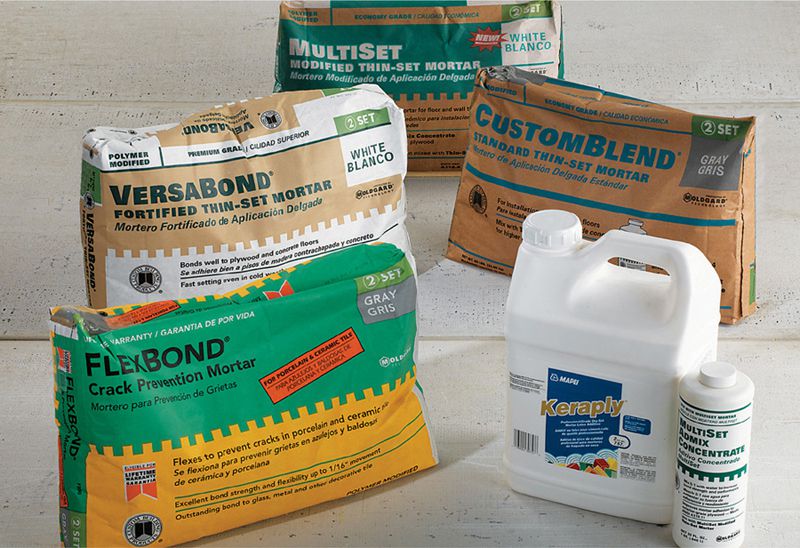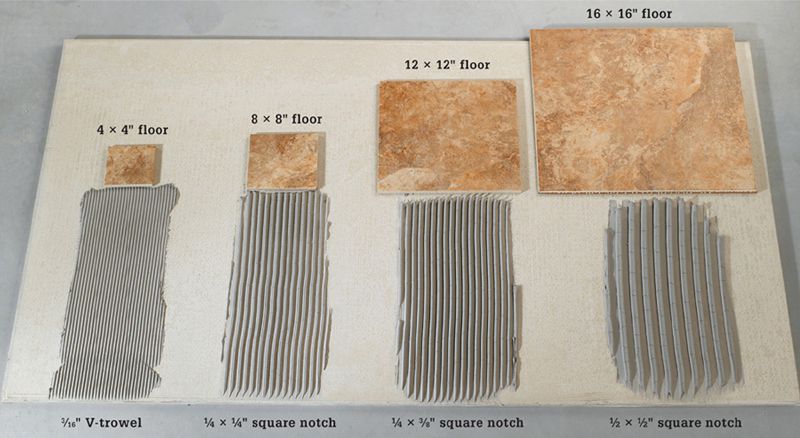
Introduced in the early 1950s, thinset is an adhesive mortar consisting of Portland cement, a water retentive agent, sand or aggregate (optional), and other additives. Prior to thinset, tiles were installed with a thick paste consisting of Portland cement and water. Unless they were soaked in water prior to installation, absorbent tiles would quickly soak up the moisture in the paste and fail to bond to the substrate. Thinset mortar made it possible for installers to install tile over a variety of cementitious substrates without needing to soak the tile beforehand.
Thinset mortars have improved substantially in quality and ease of use over the years. Because no two products are exactly alike, you should always read the package label carefully to make sure the product you select is an appropriate adhesive for the tile and the substrate to which it will be applied.
The adhesive mortars used for the projects in this book include dry-set thinset mortar, polymer-modified thinset mortar, and latex-modified thinset mortar. Modified thinset, the most common adhesive used, is widely employed to adhere a variety of different types of tile to cementboard and concrete substrates. Use gray thinset for darker grout selections and white thinset for lighter grout selections.
Dry-set mortars are mixed with potable water and used as a setting bed to seat backer board panels. In special circumstances, it can also be used as an adhesive to set tile.

Thinset mortar is applied in a thick layer to make a bed for setting tile. It is sold in premixed tubs and in dry powder forms—most professionals prefer to mix their own. If the product you buy has not been modified with polymer additive, you can mix in latex additive yourself. Different thinset mortars have different ratios of additives and fortifiers for specific purposes. You will also find some color variation. Most is cement gray, but white thinset intended for use with glass tile is also available. You can also use white thinset to reduce the chance of color bleedthrough if you are applying a light-colored grout.
Polymer-modified thinset mortar contains dry-polymer additives. It also should be mixed with potable water. Latex-modified thinset is prepared by mixing dry-set thinset mortar with a liquid latex additive. Although more costly and difficult to work with than conventional modified blends, liquid latex modified mortars usually offer higher bond strengths, higher flexural values, and increased water and chemical resistance.
Small quantities of mortar can be mixed by hand to a smooth and creamy consistency using a margin trowel. Larger batches of mortar can be mixed at speeds of less than 300 rpm, using a 1/2-inch drill fitted with a mixing paddle.
Cementboard setting beds are applied using a 1/4-inch square notch trowel. Use a 1/4-inch V-notch trowel to install mosaic tiles two inches square or less. Most varieties of larger tile can be installed using a 1/4-inch or 3/8-inch square or U-notch trowel. Very large tiles and certain types of stone may require larger trowel sizes.

The type of trowel used to apply thinset is dictated mostly by the size of the tile being installed.